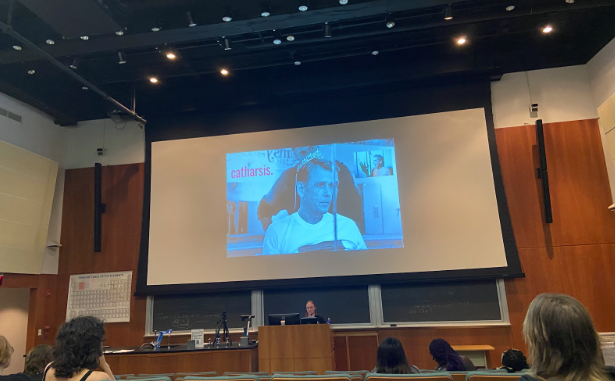
In the midst of the Halloween season, queer historian and horror film scholar Abigail Waldron returned to her alma mater, SUNY New Paltz, to give a lecture about her book “Queer Screams: A History of LGBTQ+ Survival Through the Lens of American Horror Cinema.” The book explores the reflection, representation and reclamation of the queer experience in American horror films.
After graduating from SUNY New Paltz with a Bachelor’s in history in 2017, Waldron started writing “Queer Screams” as part of her Master’s thesis in American Studies at Trinity College. She found inspiration through her experience as a queer person and an avid horror fan, finally publishing the book in August 2022.
Students, community members and Waldron’s former professors gathered in the Coykendall Science Building auditorium on Oct. 17 to attend Waldron’s book talk and follow the journey of queerness in American horror. In her lecture, Waldron covered a whole generation of films from the intersex representation in “Freaks” (1932) to John Waters and the sexual revolution to “They/Them” (2022).
“We continually claim horror monsters as our own, since for a huge chunk of American history we have been labeled as the monsters,” Waldron said. “Queer folks have been used as horror since the beginning of horror and we have the right to reclaim their imagery.”
One of the central themes of Waldron’s book is that horror films often reflect the societal fears of a given time. In her lecture, Waldron made the connection between fear over the HIV/AIDS crisis and vampire films of the ‘80’s, which depicted androgynous, queer vampires ready to seduce and infect innocents with vampirism. The homosexual subtext of the genre is clear: vampirism and AIDS are both associated with blood, sexuality and contagion.
Waldron also discussed the injustices within transgender representation in horror. Many people were first exposed to transness through deranged characters like Buffalo Bill in “The Silence of the Lambs,” skewing the public’s perception of what being trans means. Waldron’s exploration of horror’s trans misrepresentation in her book is one of the only of its kind, which has generated positive feedback from readers.
Despite the Hays Code banning sexual perversion, and thus, queer sexuality in films from 1934 to 1968, Waldron managed to analyze 212 films for her book. Even though many films and characters she studied were not explicitly queer, queer people still identified with them because of “gay sensibility.”
“Gay sensibility is the ability to spot subtextual clues that corroborate the existence of a queer character or theme,” Waldron said. “Queer folks have developed this skill of identification since childhood, looking for one another in a crowd amongst family and friends to find others like us with simply a look.”
Through this lens, Waldron argues that queer people can find catharsis like actors such as Mark Patton have. Patton was the star of “A Nightmare on Elm Street 2: Freddy’s Revenge,” a horror film with strong gay subtext. Being a closeted gay man and one of the only “final boys” under the umbrella of the “final girl” trope, Patton disappeared from Hollywood after the film’s release to avoid typecasting and discrimination as a gay actor.
“After decades of hating the role that derailed his career, he has since found catharsis in that he learned just how many young gay men saw themselves on screen, many for the first time, and were inspired by the bravery of his character, Jesse,” Waldron said. “Like him, queer people can find catharsis in the reclaiming of past traumatic and problematic on-screen portrayals in horror, and this is what I hope my book facilitates for readers.”
